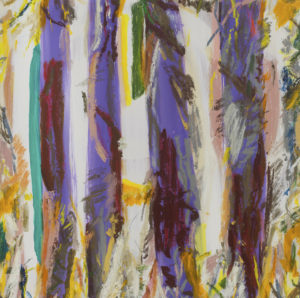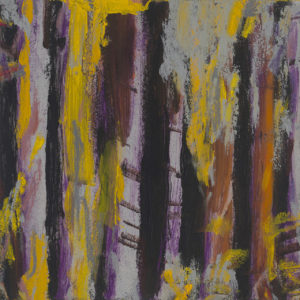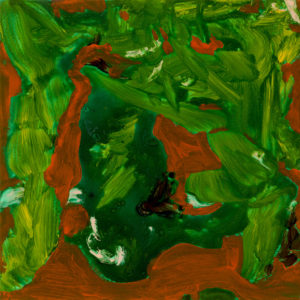Of Fire and Optimism
By Philip Gerstein | October 12, 2020
As fate would have it, this painting is hanging right now at the Provincetown Art Museum, in a group show in their spacious exhibition gallery. “In the Spirit of Fire” was painted back in 2017, in oil stick, acrylic, pigment and mixed media on a 24” x 24” wood panel. Owing to our pandemic lockdown, it’s been hanging there all of this Spring and Summer, until the Museum has finally reopened. By that time, the title of this painting, channeled from somewhere in the ether—as was most of the painting itself—this title has become more relevant, revelatory.
My painting titles always come after the work is finished. And it’s no accident that this painting is called “IN the Spirit of Fire”, NOT “Spirit of Fire.” The distinction underscores the fact that this artwork is not a representation, an allusion, or a symbol, nor an attempt to capture Nature, or to recapture some natural phenomenon—but is an independent, physical entity all its own. Was it not Kandinsky who had so eloquently pointed out, a full century before, that Art and Nature are different and are equal.
In many ways, it is fascinating to what extent we’re still party to the nineteenth century ways of thinking, that prefers its art to be narrative and illustrational—and this is how most of us, it seems, are still raised and educated.
Pandemic lockdowns are a good time to read up on your favorite artists. I’ve been reading up on one of the greats mentioned above—Vasily Kandinsky—my compatriot, fellow escapee from Soviet Russia, and one of the fully conscious originators of abstraction in art. He also happens to be a heck of a painter, whose work holds up marvelously into our new century, our new millennium. His theoretical and autobiographical writings on art are filled with insight—and incidentally produced this, somewhat provocative to the contemporary ear quote:
Kandinsky defined understanding in art as the “Heranbildung des Zuschauers auf den Standpunkt des Künstlers” = Education of the viewer to reach the standpoint of the artist… .
At the time he wrote it, in Europe ca. 1910, it was quite possible to view the position and social function of the artist as much more defined, acknowledged, even elevated, than what we’ve come to expect in our own time, country and society. Kandinsky could see the position of an artist, such as himself and his artist friends in the vanguard of modern art, as—if not a prophet—then at least a seer… .
These days, we would rather refer to the artist as sometimes able to catch the general Zeitgeist, to ride the wave of our time, to feel the pulse of humanity before the society as a whole becomes aware of its beat. Thus I have noticed, even with my own work, that some paintings appear to be ahead of their own moment in time. If initially they may feel ‘difficult’ or harder to ‘see’, then in a year, or two or five or more, they seem to be reborn as perfectly comprehendible and even appropriate.
The second painting here may or may not support this argument. It is 18” square, in acrylic on wood panel. It was completed some time last year, and put away almost immediately. It made me somehow uncomfortable. For those of you who know my work, it is uncharacteristically ‘brushy’ and the space it occupies is foreshortened, constrained. In truth, I found it a little scary. A title came shortly after: “An Eye for an Eye Makes the Whole World Blind.” It’s often hard for me, and indeed unnecessary, to determine where the titles come from. They are often as indirect and lyrically suggestive as poetry. This discovered title, however, aligns my painting more directly with our currently scary reality.

“Morningside: Beyond the Pillars of Heracles,” oil stick, acrylic, and textural media on wood panel, 30″ x 30,” 2020
This third—painting is larger, at 30” x 30”, in oil stick, acrylic, & very pronounced textural media on wood panel. It was finished late last Winter, in all of its brightness, even brashness—and almost immediately acquired this distinct title—“Morningside: Beyond the Pillars of Heracles.” As for the meaning of both the title and the painting itself, I cannot vouch. I trust it shall become clearer as the Zeitgeist catches up with them—though not being in oracular business, I could not say when, only that it is likely… .
All I can tell, there is clearly a time of optimism ahead… and if the artists have their own role to play to bring that about, with the means at their disposal, Amen to that!
Copyright © 2020 Philip Gerstein
Born and raised in Moscow, USSR, Philip Gerstein began exhibiting his work in the 1980’s with the Boston Visual Artists Union, after pursuing a PhD in Art History at Harvard University. He studied painting at the School of the Museum of Fine Arts, Boston, and Japanese calligraphy with Toshu Ogawa. Philip has been exhibiting in NYC, Provincetown MA, and very extensively in the Boston area, as well as organizing and curating painting and photography shows. His work has been reviewed, reproduced and praised in numerous publications, including The Boston Globe, ArtScope Magazine, and Art New England, and he is the author of the prize-winning essay, “Art of Color: Beauty in art comes in so many forms; art of color is a special case of it.” International Painting Annual 4. 1st. Cincinnati: Manifest Press, 2014. His work is in numerous private collections in NYC, in New England, and in Virginia.

